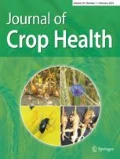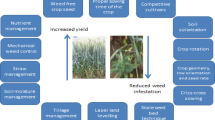Abstract
During the past few decades, extensive use of herbicides has created ecological and environmental problems such as dominance of minor weeds due to their resistance to herbicides, and human health hazards. Recognising these problems, an experiment was conducted in two consecutive wheat seasons during 2012–2014 in Central Bangladesh to evaluate five weed control methods: (i) control (weedy check), (ii) one hand weeding (one HW) at 25 days after sowing (DAS), (iii) one mechanical weeding by using a BARI dry land weeder (BARI weeder) at 25 DAS, (iv) Mechanical weeding by using a power tiller operated weeder (PTOW) at 25 DAS, and (v) chemical weed control (herbicide) by using carfentrazone + isoproturon (affinity at the rate of 5.75 g a.i. ha−1). Results revealed that one HW at 25 DAS resulted in lowest weed density (numbers m−2) and weed dry biomass (g m−2), but highest weed control efficiency (WCE %), followed by the application of herbicide, using either PTOW or BARI weeder at 25 DAS. Consequently, one HW at 25 DAS produced the highest grain yield of wheat followed by PTOW, herbicide, and BARI weeder, while the weedy check treatment produced the lowest yield. Grain yield increased over weedy check by 28, 24, 18, and 15% in one HW, PTOW, herbicide and BARI weeder, respectively. The weed control treatment PTOW also resulted in the highest benefit-cost ratio (BCR) and marginal benefit-cost ratio (MBCR) (1.5 and 10.4, respectively) followed by the herbicide, hand weeding, and BARI weeder treatments. Considering the negative effect of herbicides on the environment and the labour crisis during the peak period of weed control for manual weeding wheat farmers can use PTOW which would also reduce the weeding costs as well as increase yield and net return. However, manual weeding would still remain an option for the resource-poor farmers with abundant family labour.
Zusammenfassung
Während der letzten Jahrzehnte hat der extensive Einsatz von Herbiziden zu ökologischen und Umweltproblemen geführt, z. B. zur Dominanz kleinerer Unkräuter aufgrund ihrer Resistenz gegen Herbizide, sowie zur Gefährdung der menschlichen Gesundheit. Um diese Probleme anzugehen, wurde in Zentral-Bangladesch in zwei aufeinanderfolgenden Weizensaisons im Zeitraum 2012–2014 ein Experiment zur Beurteilung von fünf Methoden zur Unkrautbekämpfung durchgeführt: (i) Kontrolle (keine Behandlung), (ii) manuelles Unkrautjäten (hand weeding, HW) 25 Tage nach der Aussaat (days after sowing, DAS), (iii) mechanische Unkrautbekämpfung (BARI-Unkrautvernichter) 25 DAS, (iv) mechanische Unkrautbekämpfung mit einem mit einer Motorhacke betriebenen Unkrautvernichter (power tiller operated weeder, PTOW) 25 DAS und (v) chemische Unkrautbekämpfung (Herbizid) mit Carfentrazon + Isoproturon (Affinität mit einer Rate von 5.75 g a.i. ha−1). Die Ergebnisse zeigten, dass HW zur geringsten Unkrautdichte und Unkrauttrockenmasse führte, und die höchste Unkrautbekämpfungseffizienz (WCE %) zur Folge hatte; gefolgt von der Anwendung des Herbizids, PTOW- und BARI-Unkrautvernichtung. Folglich ergab HW den höchsten Kornertrag, gefolgt von PTOW, Herbizid und BARI, während die Kontrolle den niedrigsten Ertrag erbrachte. Der Kornertrag stieg gegenüber der Kontrolle bei HW, PTOW, Herbizid und BARI um 28, 24, 18 bzw. 15 %. Die PTOW-Methode führte ebenfalls zu dem höchsten Nutzen-Kosten-Verhältnis (BCR) und Grenznutzen-Kosten-Verhältnis (MBCR) (1,5 bzw. 10,4), gefolgt von der Herbizid‑, HW- und BARI-Behandlung. In Anbetracht der negativen Auswirkungen der Herbizide auf die Umwelt und der Knappheit der Arbeitskräfte während der Hauptzeit der Unkrautbekämpfung können die Weizenbauern bei der manuellen Unkrautbekämpfung PTOW einsetzen, was ebenfalls die Unkrautbekämpfungskosten senken sowie den Ertrag und den Nettogewinn erhöhen würde. Die manuelle Unkrautbekämpfung bleibt jedoch weiterhin eine Option für ressourcenarme Landwirte mit ausreichend familiären Arbeitskräften.







Similar content being viewed by others
References
Ahmed S, Chauhan BS (2014) Performance of different herbicides in dry-seeded rice in Bangladesh. Sci World J. https://doi.org/10.1155/2014/729418
Ahmed S, Chauhan BS (2015) Efficacy and phytotoxicity of different rates of oxadiargyl and Pendimethalin in dry-seeded rice (Oryza sativa L.) in Bangladesh. Crop Prot 72:169–174
Ahmed S, Alam MJ, Awan TH, Islam AKMM (2019) Herbicidal weed control in drill sown spring wheat under Bangladesh condition. Fund App Agril 4(2):839–848
Ahmed S, Alam MJ, Awan TH, Chauhan BS (2020) Effect of application timings and tank mixture of herbicides on weed suppression, crop growth and yield of wheat. J Res Weed Sci 3(2):214–229
Baghestani MA, Zand E, Soufizadeh S, Mirvakili M, Jaafarzadeh N (2007) Response of winter wheat (Triticum aestivum L.) and weeds to tank mixtures of 2, 4‐D plus MCPA with clodinafop propargyl. Weed Biol Manag 7(4):209–218. https://doi.org/10.1111/j.1445-6664.2007.00258.x
Barma NC, Hossain A, Hakim MA, Mottaleb KA, Alam MA, Reza MM, Rohman MM (2019) Progress and challenges of wheat production in the era of climate change: a Bangladesh perspective. In: Hasanuzzaman M, Nahar K, Hossain M (eds) Wheat production in changing environments. Springer, Singapore, pp 615–679 https://doi.org/10.1007/978-981-13-6883-7_24
Chauhan BS, Ahmed A, Awan TH, Jabran K, Manalil S (2015) Integrated weed management approach to improve weed control efficiencies for sustainable rice production in dry-seeded systems. Crop Prot 71:19–24
Cloutier DC, Van der Weide RY, Peruzzi A, Leblanc ML (2007) Mechanical weed management. Non-chemical weed management. CAB International, Oxfordshire, pp 111–134
Core Team R (2013) A language and environment for statistical computing. R Foundation for Statistical Computing, Vienna (http://www.R-project.org/)
Estorninos JLE, Gealy DR, Gbur EE, Talbert RE, Mc-Clleland MR (2005) Rice and red rice interference. II. Rice response to population densities of three red rice (Oryza sativa) ecotypes. Weed Sci 53:683–689
Fahad S, Hussain S, Chauhan BS, Saud S, Wu C, Hassan S, Tanveer M, Jan A, Huang J (2015) Weed growth and crop yield loss in wheat as influenced by row spacing and weed emergence times. Crop Prot 71:101–108
Gardner FP, Pearce RB, Mitchell RL (1985) Physiology of Crop Plants. IowaState University Press, Ames, pp 98–131
Gongotchame S, Dieng I, Ahouanton K, Johnson JM, Alognon AD, Tanaka A, Atta S, Saito K (2014) Participatory evaluation of mechanical weeders in lowland rice production systems in Benin. Crop Prot 61:32–37
Hellevang KJ (1995) Grain moisture content effects and management. Department of Agricultural and Biosystems Engineering, North Dakota State University. http://www.ag.ndsu.edu/pubs/plantsci/crops/ae905w.htm. Accessed on 10 December 2020
Hoque MA, Matin MA, Wahab MA, Hossain MA, Ahmed S (2010) Design and development of a power weeder for row crop. J Agric Eng 38(2):93–101
Horowitz M (1972) Growth, tuber formation and spread of Cyperus rótundus L. from single tubers. Weed Res 12:348–363
Hossain A, Farhad M, Jahan MAHS, Mahboob MG, Timsina J, Teixeira da Silva JA (2018) Biplot yield analysis of heat-tolerant spring wheat genotypes (Triticum aestivum L.) in multiple growing environments. Open Agric 3(1):404–413
Hossain A, Mottaleb KA, Farhad M, Barma NCD (2019) Mitigating the twin problems of malnutrition and wheat blast by one wheat variety, ‘BARI Gom 33’, in Bangladesh. Acta Agrobot 72(2):1775. https://doi.org/10.5586/aa.1775
Hossain A, Sarker MAZ, Saifuzzaman M, Teixeira da Silva JA, Lozovskaya MV, Akhter MM (2013) Evaluation of growth, yield, relative performance and heat susceptibility of eight wheat (Triticum aestivum L.) genotypes grown under heat stress. Int J Plant Prod 7(3):615–636
Hossain MA, Islam MS, Huda MD, Zami MA, Bhuyan MGK, Nath BC (2011) Design and development of a weeder for both lowland and upland conditions. Agricultural mechanization in Asia, Arica and Latin America. Farm Mach Ind Res Corp 42(2):56–62
Hossen MA, Alam MA, Paul S, Hossain MA (2019) Modification and evaluation of a power weeder for Bangladesh condition. Eco-friendly Agric J 8(3):37–46
Hussain S, Khaliq A, Matloob A, Fahad S, Tanveer A (2015) Interference and economic threshold level of little seed canary grass in wheat under different sowing times. Environ Sci Poll Res 22:441–449. https://doi.org/10.1007/s11356-014-3304-y
Jabran K, Ali A, Sattar A, Ali Z, Yasin M, Hussain M (2012) Cultural, mechanical and chemical weed control in wheat. Crop Environ 3:50–53
Jabran K, Mahmood K, Melander B, Bajwa AA, Kudsk P (2017) Weed dynamics and management in wheat. Adv Agron 145:97–166
Jahan MAHS, Hossain A, Timsina J, da Silva JAT (2018) Evaluation of tolerance of six irrigated spring wheat (Triticum aestivum L.) genotypes to heat stress using stress tolerance indices and correlation analysis. Int J Agric Res 13:39–52. https://doi.org/10.3923/ijar.2018.39.52
Khaliq A, Gondal MR, Matloob A, Ullah E, Hussain S, Murtaza G (2013a) Chemical weed control in wheat under different rice residue management options. Pak J Weed Sci Res 19:1–14
Khaliq A, Hussain S, Matloob A, Wahid A, Aslam F (2013b) Aqeous swine cress (Coronopus didymus) extracts inhibit wheat germination and early seedling growth. Int J Agric Biol 15:743–748
Khaliq A, Shakeel M, Matloob A, Hussain S, Tanveer A, Murtaza G (2013c) Influence of tillage and weed control practices on growth and yield of wheat. Philip J Crop Sci 38:54–62
Kumar N, Hazra KK, Yadav SL, Singh SS (2015) Weed management using post-emergence herbicides in chickpea (Cicer arietinum)+ mustard (Brassica juncea) intercropping system. Indian J Agric Sci 85(8):1074–1079
Marwat KB, Saeed M, Gul B, Hussain Z (2006) Performance of different herbicides in wheat (Triticum aestivum L.) under rainfed conditions of kohat, Pakistan. Pak J Weed Sci Res 12:163–168
Matin MA, Desbiolles JMA, Jahan MAHS (2010) Technology and Innovation for Sustainable Development International Conference. Faculty of Engineering, Khon Kaen University, Thalind, pp 1–8
Narwariya BS, Tiwari KB, Shrivastava P (2016) Performance evaluation of different manual operated weeding equipment for Paddy crop in vertisols. Eco Env Cons 22:357–363
Olaoye JO, Adekanye TA (2011) Analysis of the motion of weeding tools and development of a rotary power weeder. J Agril Engin Technol 19(2):9–25
Safdar ME, Asif M, Ali A, Aziz A, Yasin M, Aziz M, Afzal M, Ali A (2011) Comparative efficacy of different weed management strategies in wheat. Chilean J Agric Res 71(2):195–203
Shehzad MA, Maqsood M, Anwar-ul-Haq M, Niaz A (2012) Efficacy of various herbicides against weeds in wheat (Triticum aestivum L.). Afr J Biotechnol 11:791–799
Subudhi ECR (2004) Evaluation of weeding devices for upland rice in the eastern Ghat of Orissa, India. Int Rice Res Not 29(1):79–81
Funding
The study was based on the core-funded research program of the Regional Wheat Research Centre and Farm Power and Machinery Division of the Bangladesh Agricultural Research Institute (BARI), Joydebpur, Gazipur-Bangladesh.
Author information
Authors and Affiliations
Corresponding author
Ethics declarations
Conflict of interest
M.A.H.S. Jahan, A. Hossain, M.A. Hoque, K.K. Saha, K.K. Sarker, S. Ahmed and J. Timsina declare that they have no competing interests.
Supplementary Information
10343_2020_539_MOESM1_ESM.docx
Supplementary Table 1S and IS, included the data on weed control efficiency as influenced by the different weed control methoy and yield contributing characters as influenced by different weed control methods
Rights and permissions
About this article
Cite this article
Jahan, M.A.H.S., Hossain, A., Hoque, M.A. et al. Evaluation of Economically Viable and Environmental Friendly Weed Control Methods for Wheat (Triticum aestivum L.). Gesunde Pflanzen 73, 209–218 (2021). https://doi.org/10.1007/s10343-020-00539-x
Received:
Accepted:
Published:
Issue Date:
DOI: https://doi.org/10.1007/s10343-020-00539-x




